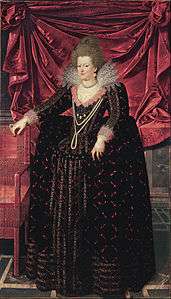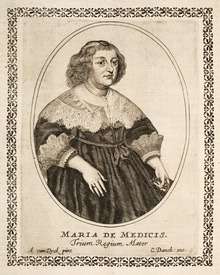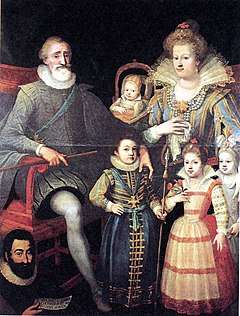Marie de' Medici
Marie de' Medici (French: Marie de Médicis, Italian: Maria de' Medici; 26 April 1575 – 3 July 1642) was Queen of France as the second wife of King Henry IV of France, of the House of Bourbon. She was a member of the wealthy and powerful House of Medici. Following the assassination of her husband in 1610, which occurred the day after her coronation, she acted as regent for her son, King Louis XIII of France, until 1617, when he came of age.[1] She was noted for her ceaseless political intrigues at the French court and extensive artistic patronage.[2]
| Marie de Medici | |
|---|---|
.jpg) Portrait by Frans Pourbus the Younger, 1610 | |
| Queen consort of France and Navarre | |
| Tenure | 17 December 1600 – 14 May 1610 |
| Coronation | 13 May 1610 |
| Born | 26 April 1575 Palazzo Pitti, Florence, Tuscany |
| Died | 3 July 1642 (aged 67) Cologne, Holy Roman Empire |
| Burial | Basilica of St Denis, Paris, France |
| Spouse | |
| Issue |
|
| House | Medici |
| Father | Francesco I, Grand Duke of Tuscany |
| Mother | Joanna of Austria |
| Religion | Roman Catholicism |
| Signature |  |
Early life
She was born as Maria at the Palazzo Pitti of Florence, Italy, the sixth daughter of Francesco I de' Medici, Grand Duke of Tuscany, and Archduchess Joanna of Austria.[3] Marie was a descendant of Lorenzo the Elder, a branch of the Medici family sometimes referred to as the 'cadet' branch. She did descend from Lorenzo in the female line however, through his daughter Lucrezia de' Medici. She was also a Habsburg through her mother, who was a direct descendant of Joanna of Castile and Philip I of Castile.
Marie was one of seven children, but only she and her eldest sister Eleonora survived to adulthood.

A portrait of Marie as a young girl shows her with regular features and a high forehead. Her wavy hair was light brown in colour, and she had honey-brown eyes and fair skin. The painter was from the school of Santi di Tito.
Queen of France
She married Henry IV of France in October 1600 following the annulment of his marriage to Margaret of Valois.[3] The wedding ceremony was held in Florence, and was celebrated by four thousand guests with lavish entertainment, including examples of the newly invented musical genre of opera, such as Jacopo Peri's Euridice. Henry did not attend the ceremony, and the two were therefore married by proxy. Marie brought as part of her dowry 600,000 crowns. Her eldest son, the future King Louis XIII, was born at Fontainebleau the following year.
Her husband was almost 47 at the marriage and had a long succession of mistresses. Dynastic considerations required him to take a second wife, his first spouse Margaret of Valois never having produced children by Henry or by her lovers. Henry chose Marie de' Medici because Henry "owed the bride's father, Francesco de' Medici, Grand Duke of Tuscany, who had helped support his war effort, a whopping 1,174,000 écus and this was the only means Henry could find to pay back the debt...."[4]
The marriage was successful in producing children, but it was not a happy one. The queen feuded with Henry's mistresses in language that shocked French courtiers. She quarreled mostly with her husband's leading mistress, Catherine Henriette de Balzac d'Entragues, whom he had promised he would marry following the death of his former "official mistress", Gabrielle d'Estrées.[5] When he failed to do so, and instead married Marie, the result was constant bickering and political intrigues behind the scenes. Catherine referred to Maria as "the fat banker's daughter"; Henry used Maria for breeding purposes exactly as Henry II had treated Catherine de' Medici.[6] Although the king could have easily banished his mistress, supporting his queen, he never did so. She, in turn, showed great sympathy and support to her husband's banished ex-wife Marguerite de Valois, prompting Henry to allow her back into the realm.
Marie was crowned Queen of France on 13 May 1610, a day before her husband's death. Hours after Henry's assassination, she was confirmed as regent by the Parliament of Paris. She immediately banished his mistress, Catherine Henriette de Balzac, from the court.[7]
Politics

Regency
Marie was under suspicion at court because she was perceived as a foreigner and never truly mastered French.[8] She was heavily influenced by Italian friends and confidants, including her foster sister Leonora "Galigai" Dori. (They shared the Italian-Portuguese physician of Jewish extraction Elijah Montalto.) Dori's Italian husband, Concino Concini, was created Marquis d'Ancre and a Marshal of France, even though he had never fought a battle.[9]
The Concinis had Henry IV's able minister, the Duke of Sully, dismissed, and Italian representatives of the Roman Catholic Church hoped to force the suppression of Protestantism in France by means of their influence. However, Marie maintained her late husband's policy of religious tolerance. As one of her first acts, Marie reconfirmed Henri IV's Edict of Nantes, which ordered religious tolerance for Protestants in France while asserting the supremacy of the Roman Catholic Church.
Daughter of a Habsburg princess, Marie abandoned the traditional anti-Habsburg French foreign policy. She lent support to Habsburg Spain by arranging the marriage of her daughter Elisabeth to the future Philip IV of Spain. Marie overturned the Treaty of Bruzolo, an alliance signed between Henry's representatives and Charles Emmanuel I, Duke of Savoy.
Under the regent's rule, the princes of the blood and the great nobles of the kingdom revolted. The queen consented to buy them off on 15 May 1614. The opposition to the regency was led by Henri de Bourbon, Duke of Enghien, who pressured Marie into convoking the Estates General in 1614 and 1615.
In 1616 Marie's rule was strengthened by the addition to her councils of Armand Jean du Plessis (later Cardinal Richelieu), who had come to prominence at the meetings of the Estates General. However, her son Louis XIII, already several years into his legal majority, asserted his authority the next year. The king overturned the pro-Habsburg, pro-Spanish foreign policy pursued by his mother, ordered the assassination of Concini, exiled the queen to the Château de Blois and appointed Richelieu to his bishopric.

Revolt of 1619
After two years of virtual imprisonment "in the wilderness", as she put it, Marie escaped from Blois in the night of 21/22 February 1619 and became the figurehead of a new aristocratic revolt headed by Louis's brother Gaston, Duke of Orléans, whose forces Louis easily dispersed.
Through the mediation of Richelieu the king was reconciled with his mother, who was allowed to hold a small court at Angers.
She resumed her place in the royal council in 1621. The portrait by Rubens was painted at this time. When Marie rebuilt the Luxembourg Palace in Paris, she added this extravagantly flattering cycle of her paintings by Rubens as part of the luxurious decoration. This collection was called the Marie de' Medici Cycle.

Conflict with Richelieu
After the death of his favourite, the duke of Luynes, Louis turned increasingly for guidance to Richelieu. Marie de' Medici's attempts to displace Richelieu ultimately led to her attempted coup; for a single day, the "Day of the Dupes", in November 1630, she seemed to have succeeded; but the triumph of Richelieu was followed by her self-exile to Compiègne[10] in 1630, from where she escaped to Brussels in 1631 and Amsterdam in 1638.
Exile
Her visit to Amsterdam was considered a diplomatic triumph by the Dutch, as it lent official recognition to the newly formed Dutch Republic; accordingly she was given an elaborate ceremonial royal entry, of the sort the Republic avoided for its own rulers.
Spectacular displays (by Claes Corneliszoon Moeyaert) and water pageants took place in the city's harbour in celebration of her visit. There was a procession led by two mounted trumpeters, and a large temporary structure was erected on an artificial island in the Amstel River especially for the festival. The structure was designed to display a series of dramatic tableaux in tribute to her once she set foot on the floating island and entered its pavilion. Afterwards she was offered an Indonesian rice table by the burgomaster Albert Burgh. He also sold her a famous rosary, captured in Brazil. The visit prompted Caspar Barlaeus to write his Medicea hospes ("The Medicean Guest", 1638).
She also visited England in 1638 (her youngest daughter was Queen Henrietta Maria), staying en route to London in Gidea Hall.
Marie subsequently travelled to Cologne, where she died in 1642, scheming against Richelieu to the end.
She was buried in the Basilica of St Denis in northern Paris.
Artistic patronage
The construction and furnishing of the Palais du Luxembourg, which she referred to as her "Palais Médicis", formed her major artistic project during her regency. The site was purchased in 1612 and construction began in 1615, to designs of Salomon de Brosse. In 1621, when she regained status in the royal court, Flemish painter Peter Paul Rubens was commissioned to create a 21-piece series glorifying her life and reign. This series, along with three individual portraits made for Marie and her family, is now known as the Marie de' Medici cycle. The cycle uses iconography throughout to depict Henry IV and Marie as Jupiter and Juno and the French state as a female warrior.
It was well known that Henry of Navarre (her husband) was not wealthy. She brought her own fortune from Florence to finance various construction projects in France. But more importantly, she contributed to the financing of several expeditions including Samuel de Champlain's to North America, which saw France lay claim to Canada.[26]
Posthumous appraisal
Honoré de Balzac, in his essay Catherine de Medicis, encapsulated the Romantic generation's negative view. She was born and raised in Italy and the French never really accepted her; hence, the negative reviews. However, Henry IV of Navarre was not a rich man and needed Marie's money. The French were still not pleased with his choosing an Italian wife.
Marie de' Medici, all of whose actions were prejudicial to France, has escaped the shame which ought to cover her name. Marie de' Medici wasted the wealth amassed by Henry IV; she never purged herself of the charge of having known of the king's assassination; her intimate was d'Épernon, who did not ward off Ravaillac's blow, and who was proved to have known the murderer personally for a long time. Marie's conduct was such that she forced her son to banish her from France, where she was encouraging her other son, Gaston.

Issue
| Name | Birth | Death | Notes |
|---|---|---|---|
| Louis XIII, King of France | 27 September 1601 | 14 May 1643 | Married Anne of Austria (1601–1666) in 1615. Two sons survived to adulthood. |
| Elisabeth, Queen of Spain | 22 November 1602 | 6 October 1644 | Married Philip IV, King of Spain (1605–1665) in 1615. A son and a daughter survived to adulthood. |
| Christine, Duchess of Savoy | 10 February 1606 | 27 December 1663 | Married Victor Amadeus I, Duke of Savoy (1587–1637) in 1619. One son and three daughters survived to adulthood. |
| Nicholas Henri, Duke of Orléans | 16 April 1607 | 17 November 1611 | Died young. |
| Gaston, Duke of Orléans | 25 April 1608 | 2 February 1660 | Married (1) Marie de Bourbon (1605–1627) in 1626. 1 daughter survived to adulthood. Married (2) Marguerite of Lorraine (1615–1672) in 1632. Three daughters survived to adulthood. |
| Henrietta Maria, Queen of England | 25 November 1609 | 10 September 1669 | Married Charles I, King of England (1600–1649) in 1625. Three sons and two daughters survived to adulthood. |
Ancestry
| Ancestors of Marie de' Medici | |||||||||||||||||||||||||||||||||||||||||||||||||||||||||||||||||||||||||||||||||||||||||||||||||||||||||||||||||||||||||||||||||||||||||||||||||||||||||||||||||||||||||||||||||||||||||||||||||||||||||||||||||||||||||||||||||||||||||||||||||||||||||||||||||||||||||||||||||||||||||
|---|---|---|---|---|---|---|---|---|---|---|---|---|---|---|---|---|---|---|---|---|---|---|---|---|---|---|---|---|---|---|---|---|---|---|---|---|---|---|---|---|---|---|---|---|---|---|---|---|---|---|---|---|---|---|---|---|---|---|---|---|---|---|---|---|---|---|---|---|---|---|---|---|---|---|---|---|---|---|---|---|---|---|---|---|---|---|---|---|---|---|---|---|---|---|---|---|---|---|---|---|---|---|---|---|---|---|---|---|---|---|---|---|---|---|---|---|---|---|---|---|---|---|---|---|---|---|---|---|---|---|---|---|---|---|---|---|---|---|---|---|---|---|---|---|---|---|---|---|---|---|---|---|---|---|---|---|---|---|---|---|---|---|---|---|---|---|---|---|---|---|---|---|---|---|---|---|---|---|---|---|---|---|---|---|---|---|---|---|---|---|---|---|---|---|---|---|---|---|---|---|---|---|---|---|---|---|---|---|---|---|---|---|---|---|---|---|---|---|---|---|---|---|---|---|---|---|---|---|---|---|---|---|---|---|---|---|---|---|---|---|---|---|---|---|---|---|---|---|---|---|---|---|---|---|---|---|---|---|---|---|---|---|---|---|---|---|---|---|---|---|---|---|---|---|---|---|---|---|---|---|---|
| |||||||||||||||||||||||||||||||||||||||||||||||||||||||||||||||||||||||||||||||||||||||||||||||||||||||||||||||||||||||||||||||||||||||||||||||||||||||||||||||||||||||||||||||||||||||||||||||||||||||||||||||||||||||||||||||||||||||||||||||||||||||||||||||||||||||||||||||||||||||||
References
- Lawrence, Cynthia Miller (1997). Women and Art in Early Modern Europe: Patrons, Collectors, and Connoisseurs. Pennsylvania State Univ Pr. p. 136. ISBN 978-0-271-01568-2.
- Lawrence, Cynthia Miller (1997). Women and Art in Early Modern Europe: Patrons, Collectors, and Connoisseurs. Marie de Médici's Patronage of Art and Architecture: Pennsylvania State Univ Pr. ISBN 978-0-271-01568-2.
- Chiarini 2002, p. 77.
- Goldstone, Nancy, The Rival Queens, (Little Brown and Company, 2015), p. 377
- THE AMERICAN CYCLOPEADIA. 1874. pp. 671–. Retrieved 21 February 2011.
- Goldstone, Nancy, The Rival Queens, (Little Brown and Company, 2015), footnote: p. 377
- Herman, Eleanor (2005). Sex with Kings: 500 Years of Adultery, Power, Rivalry, and Revenge. p. 80. ISBN 9780061751554.
- Fischer, David Hackett, 1935- (2008). Champlain's dream (1st Simon & Schuster hardcover ed.). New York: Simon & Schuster. ISBN 978-1-4165-9332-4. OCLC 213839989.CS1 maint: multiple names: authors list (link)
- "Concino Concini, marquis d'Ancre | Italian diplomat". Encyclopedia Britannica. Retrieved 4 January 2020.
- Bergin, Joseph (1 March 1990). Cardinal Richelieu: Power and the Pursuit of Wealth. New Haven, CT: Yale University Press. p. 86. ISBN 978-0-300-04860-5. Retrieved 19 March 2016.
- "The Medici Granducal Archive and the Medici Archive Project" (PDF). p. 12. Archived from the original (PDF) on 15 January 2006.
- Cesati, Franco (1999). Medici. Firenze: La Mandragora. p. 75. ISBN 88-85957-36-6.
- Chisholm, Hugh, ed. (1911). . Encyclopædia Britannica. 15 (11th ed.). Cambridge University Press.
- Wurzbach, Constantin, von, ed. (1860). . Biographisches Lexikon des Kaiserthums Oesterreich [Biographical Encyclopedia of the Austrian Empire] (in German). 6. p. 290 – via Wikisource.
- Cazacu, Matei (2017). Reinert, Stephen W. (ed.). Dracula. Brill. p. 204.
Sources
- Chiarini, Marco (2002). "Cosimo II and Maria Maddalena of Austria". The Medici, Michelangelo, & the Art of Late Renaissance Florence. Yale University Press.CS1 maint: ref=harv (link)77
- Helga Hübner and Eva Regtmeier (2010), Maria de' Medici: eine Fremde; hrsg. v. Dirk Hoeges (Dialoghi/Dialogues: Literatur und Kultur Italiens und Frankreichs; Band 14). Frankfurt: Peter Lang ISBN 978-3-631-60118-1
External links
| Wikimedia Commons has media related to Maria de' Medici. |
- Rubens cycle of paintings apotheosizing Marie de Medici Definitive statements of Baroque art.
- National Maritime Museum
- Drawing by Claes Cornelisz. Moeyaert the entrance of Maria de Medici in Amsterdam
- Festival Books
- Herbermann, Charles, ed. (1913). . Catholic Encyclopedia. New York: Robert Appleton Company.
- Life of Marie dei Médicis. Engravings after Rubens from the De Verda Collection
- "Medicea Hospes, Sive Descripto Pvblicae Gratvlations: qua Serenissiman, Augustissimamque reginam, Mariam de Meicis, except Senatvs popvlvvsqve Amstelodamensis" (1638), Illustrated with engravings of Maia de' Meici
Marie de' Medici Born: 26 April 1575 Died: 3 July 1642 | ||
| French royalty | ||
|---|---|---|
| Vacant Title last held by Margaret of Valois |
Queen consort of France and Navarre 17 December 1600 – 14 May 1610 |
Vacant Title next held by Anne of Austria |
